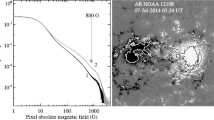Abstract
In this paper some aspects concerning the interpretation of magnetic anomalies are treated, particularly when the remanent magnetization intensity is strong. In this case, since total and induced magnetization vectors can have very different directions, a correct anomaly interpretation strictly depends on the knowledge of their declinations and inclinations.
Thus, a specific procedure is described to determine such parameters from well-known semi-empirical techniques and vectorial relations.
Furthermore, the classical definition of apparent susceptibility is shown to be inadequate to this problem and a more general formulation is suggested, which is not only related to the true susceptibility and to the Koenisberger ratio, but also to the declinations and inclinations of the induced and remanent magnetization vectors.
The two apparent susceptibilities are then compared for some synthetic magnetic anomalies and significant differences are found.
Similar content being viewed by others
References
Andreasen, G. E. andZeitz, I. (1969),Magnetic fields for a 4×6prismatic model, U.S. Geol. Surv. Prof. Pap. 666, Plates 1–210.
Carmichael, R. S.,Handbook of Physical Properties of Rocks (CRC Press, Inc., Boca Raton, Florida 1982).
Cordell, L. andTaylor, T. P. (1971),Investigation of magnetization and density of a North Atlantic seamount using Poisson's theorem. Geophysics36 (5), 919–937.
Fedi, M. andRapolla, A. (1987),Rotation of the Italian Peninsula from aeromagnetic evidences, Phys. Eart. Plan. Int., in press.
Grant, F. S. andWest, G. F.,Interpretation Theory in Applied Geophysics (McGraw-Hill, New York 1965).
Iaga Division 1 Study Group (1976),International Geomagnetic Reference Field, EOS Trans. Am. Geophys. Union57, 120–121.
Savelli, C. (1988),Late Oligocene to recent episodes of magmatism in and around the Tyrrhenian Sea: Implications for the processes of opening in a young inter-arc basin of intra-orogenic (Mediterranean) type, Tectonophysics146, 163–181.
Scandone, P. (1979),Origin of the Tyrrhenian Sea and Calabrian Arc, Boll. Soc. Geol. It.98, 27–34.
Schnetzler, C. C. andTaylor, P. T. (1984),Evaluation of an observational method for estimation of remanent magnetization, Geophysics49 (3), 282–290.
Sharma, P. V.,Geophysical Methods in Geology (Elsevier, New York 1978).
Shuey, R. T. andPasquale, A. S. (1973),End corrections in magnetic profile interpretation, Geophysics38 (3), 507–512.
Talwani, M. (1965),Computation with the help of a digital computer of magnetic anomalies caused by bodies of arbitrary shape, Geophysics30 (5), 797–817.
Zietz, I. andAndreasen, G. E. (1967),Remanent magnetization and aeromagnetic interpretation, Mining Geophysics, II, Soc. Expl. Geophys., Tulsa, Okla., 569–590.
Author information
Authors and Affiliations
Rights and permissions
About this article
Cite this article
Fedi, M. On the interpretation of magnetic anomalies for strong remanent magnetizations. PAGEOPH 130, 721–733 (1989). https://doi.org/10.1007/BF00881607
Received:
Revised:
Accepted:
Issue Date:
DOI: https://doi.org/10.1007/BF00881607




